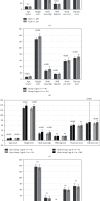Salivary Biomarkers (Opiorphin, Cortisol, Amylase, and IgA) Related to Age, Sex, and Stress Perception in a Prospective Cohort of Healthy Schoolchildren
- PMID: 35110971
- PMCID: PMC8801773
- DOI: 10.1155/2021/3639441
Salivary Biomarkers (Opiorphin, Cortisol, Amylase, and IgA) Related to Age, Sex, and Stress Perception in a Prospective Cohort of Healthy Schoolchildren
Abstract
Background: The use of easily accessible biomarkers for assessing young patients' health is weighty. This cohort study is aimed at measuring stress/immune biomarkers in the saliva of healthy school-age children and comparing subgroups according to age, sex, and stress perception. Material and Methods. 503 children under 12 years old (8.7 ± 1.3) were included with anthropometric evaluation (height, waist, hip circumference, body weight, and body mass index (BMI)). Levels of opiorphin (OPI), free cortisol, alpha-amylase (sAA), and secreted immunoglobulin (sIgA) were determined by quantitative assays (ELISA) in unstimulated saliva. Unpaired t-test, Welch test, and Mann-Whitney U test were applied for appropriate group comparisons, and the correlation between variables was analyzed with Spearman's rank coefficient. Results were considered significant at p < 0.05.
Results: sIgA and sAA exhibited significant differences depending on age and sex: IgA (ng/mL): 86 ± 68.6 vs. 104.9 ± 72.1 for (6-7 y.o.) and (8-11 y.o.), respectively, and 108.1 ± 80.1 vs. 94.6 ± 62.2 for male and females, respectively; sAA (U/mL): 78.9 ± 54.4 vs. 100.5 ± 81.2 for (6-7 y.o.) and (8-11 y.o.). No difference related to age or sex between groups was observed for cortisol and OPI. However, OPI levels were higher and correlated to prior stress exposure in children (0.31 ± 0.4 vs. 0.26 ± 0.5 ng/mL, p = 0.031). sAA was negatively correlated to low mood self-declaration in children in the last two weeks (r = -0.10, p = 0.045).
Conclusions: sIgA and sAA can be used as sex- and age-related biomarkers in children 6-12 y.o., which is not the case for free cortisol and opiorphin. However, OPI reflected previous exposure to stress, suggesting its use for evaluating stress-related changes in children.
Copyright © 2021 Anna Krahel et al.
Conflict of interest statement
The authors declare that they have no conflicts of interests.
Figures




Similar articles
-
Stress/Immune Biomarkers in Saliva among Children with ADHD Status.Int J Environ Res Public Health. 2021 Jan 18;18(2):769. doi: 10.3390/ijerph18020769. Int J Environ Res Public Health. 2021. PMID: 33477503 Free PMC article.
-
Is there a link between stress and immune biomarkers and salivary opiorphin in patients with a restrictive-type of anorexia nervosa?World J Biol Psychiatry. 2020 Mar;21(3):220-229. doi: 10.1080/15622975.2019.1593502. Epub 2019 Apr 23. World J Biol Psychiatry. 2020. PMID: 30880537 Clinical Trial.
-
Salivary alpha-amylase, secretory IgA and free cortisol as neurobiological components of the stress response in the acute phase of anorexia nervosa.World J Biol Psychiatry. 2016 Jun;17(4):266-73. doi: 10.3109/15622975.2016.1163419. Epub 2016 Apr 29. World J Biol Psychiatry. 2016. PMID: 26983011 Clinical Trial.
-
Salivary mental stress proteins.Clin Chim Acta. 2013 Oct 21;425:196-201. doi: 10.1016/j.cca.2013.07.028. Epub 2013 Aug 9. Clin Chim Acta. 2013. PMID: 23939251 Review.
-
Is burning mouth syndrome associated with stress? A meta-analysis.J Oral Rehabil. 2023 Nov;50(11):1279-1315. doi: 10.1111/joor.13536. Epub 2023 Jul 4. J Oral Rehabil. 2023. PMID: 37332081 Review.
Cited by
-
Expression of salivary immunoglobulins and their association with analgesic neuropeptide opiorphin in anorexia nervosa during adolescence.J Eat Disord. 2022 Aug 11;10(1):118. doi: 10.1186/s40337-022-00637-3. J Eat Disord. 2022. PMID: 35953876 Free PMC article.
-
Investigation of Perceived Stress During COVID-19 Pandemic Self-Isolation Periods.Medicina (Kaunas). 2025 Jan 21;61(2):175. doi: 10.3390/medicina61020175. Medicina (Kaunas). 2025. PMID: 40005293 Free PMC article.
-
Opiorphin as a biomarker of orofacial conditions: a meta-analysis.Sci Rep. 2023 Sep 19;13(1):15533. doi: 10.1038/s41598-023-42051-y. Sci Rep. 2023. PMID: 37726305 Free PMC article.
-
Prevalence of orofacial and head pain: an umbrella review of systematic reviews.J Oral Facial Pain Headache. 2024 Sep;38(3):1-14. doi: 10.22514/jofph.2024.022. Epub 2024 Sep 12. J Oral Facial Pain Headache. 2024. PMID: 39800567 Free PMC article.
-
The Impact of Music on Stress Biomarkers: Protocol of a Substudy of the Cluster-Randomized Controlled Trial Music Interventions for Dementia and Depression in ELderly Care (MIDDEL).Brain Sci. 2022 Apr 8;12(4):485. doi: 10.3390/brainsci12040485. Brain Sci. 2022. PMID: 35448016 Free PMC article.
References
MeSH terms
Substances
LinkOut - more resources
Full Text Sources
Miscellaneous

